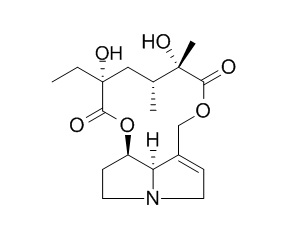Bisline
Reference standards.
Inquire / Order:
manager@chemfaces.com
Technical Inquiries:
service@chemfaces.com
Tel:
+86-27-84237783
Fax:
+86-27-84254680
Address:
1 Building, No. 83, CheCheng Rd., Wuhan Economic and Technological Development Zone, Wuhan, Hubei 430056, PRC
Providing storage is as stated on the product vial and the vial is kept tightly sealed, the product can be stored for up to
24 months(2-8C).
Wherever possible, you should prepare and use solutions on the same day. However, if you need to make up stock solutions in advance, we recommend that you store the solution as aliquots in tightly sealed vials at -20C. Generally, these will be useable for up to two weeks. Before use, and prior to opening the vial we recommend that you allow your product to equilibrate to room temperature for at least 1 hour.
Need more advice on solubility, usage and handling? Please email to: service@chemfaces.com
The packaging of the product may have turned upside down during transportation, resulting in the natural compounds adhering to the neck or cap of the vial. take the vial out of its packaging and gently shake to let the compounds fall to the bottom of the vial. for liquid products, centrifuge at 200-500 RPM to gather the liquid at the bottom of the vial. try to avoid loss or contamination during handling.
Mol Pharmacol.2021, 99(2):163-174.
Theoretical and Experimental Plant Physiology 2022, 34,53-62
J Agric Food Chem.2021, 69(14):4210-4222.
J Ethnopharmacol.2017, 209:305-316
Oxid Med Cell Longev2019, 9056845:13
Biomed Pharmacother.2019, 111:262-269
Expert Opin Ther Targets.2024, :1-11.
J Asian Nat Prod Res.2019, 5:1-17
Molecules.2017, 22(12)
J Nat Med.2020, 74(1):65-75
Related and Featured Products
J Anal Toxicol. 2004 Jan-Feb;28(1):11-5.
Simultaneous determination of isoline and its two major metabolites using high-performance liquid chromatography.[Pubmed:
14987418]
METHODS AND RESULTS:
A simple and reliable high-performance liquid chromatographic (HPLC) assay was developed for a simultaneous determination of isoline, a potent hepatotoxic pyrrolizidine alkaloid, and its two major metabolites, namely M1 (Bisline) and M2 (Bisline lactone, a new pyrrolizidine alkaloid). The latter two metabolites were produced during in vitro metabolism of isoline by rat and mouse microsomal enzyme systems. The analysis was conducted by a direct injection of aliquots of supernatant of the microsomal reaction mixture treated with the equal volume of ice-cold methanol onto a conventional reversed-phase analytical column (150 x 4.6 mm). The analytes were separated by a gradient elution with mobile phases A (0.01 M dihydro-potassium phosphate, pH 4.8) and B (acetonitrile). The assay has shown excellent precision and accuracy with less than 10% of overall intra- and interday variations and higher than 94% of overall accuracy.
CONCLUSIONS:
The developed HPLC method was successfully applied for the determination of the intact isoline and its two pH- and thermally labile metabolites produced in rat and mouse liver microsomal incubations.
Phytochemistry. 2000 Aug;54(8):933-5.
Structure revision of isoline (ruwenine), bisline and isolinecic acid.[Pubmed:
11014292]
METHODS AND RESULTS:
X-ray crystallography of Bisline, and the chemical interconversion of Bisline and isoline (ruwenine), revealed that the structures previously assigned to these alkaloids required revision; as did that of isolinecic acid.
Journal of the Chemical Society C Organic,1970 ,17 (17) :2312-2315.
The Senecio alkaloids. Suggested structures for isoline and bisline, two new alkaloids from Senecio othonniformis Fourcade[Reference:
WebLink]
METHODS AND RESULTS:
Plants of Senecio othonniformis Fourcade afforded the alkaloids, Bisline, C18H27NO6, and its acetate, isoline, C20H29NO7. Hydrolysis of isoline gave acetic acid, retronecine, and a new acid, isolinecic acid, C10H18O6. N.m.r. and mass spectral data and degradation studies indicate that isolinecic acid is 2,5-dihydroxy-3-methylheptane-2,5-dicarboxylic acid or its 2,4-dihydroxy-isomer.



